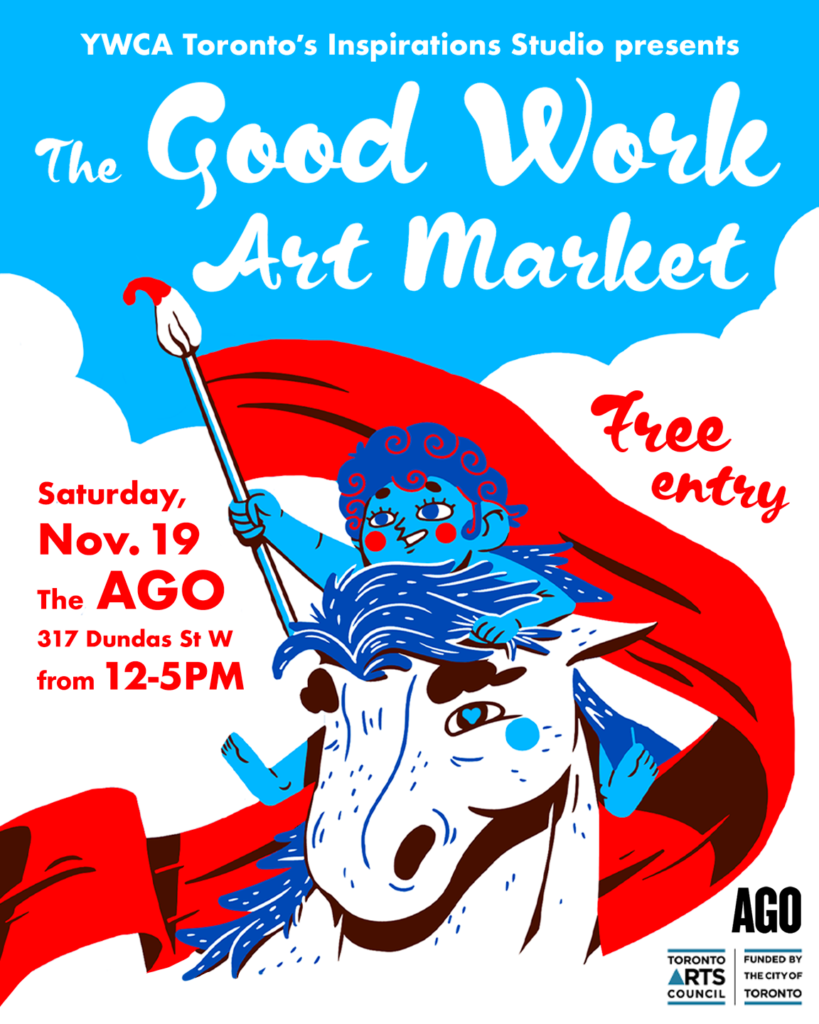Whether you’re making art or attending a fair to support other artists, there’s something you’re taking for granted. Maybe it’s access to the venue, transportation, or the financial means to support your favourite creators at all. Even on the smallest scale, these existing, invisible barriers aren’t something to guilt yourself about, but being more open and cognizant about them can help improve all the creative affairs around you.
If you’d like to see a vision of what a more accessible art world may look like, former Broken Pencil Assistant Editor Anisa Rawhani is organizing The Good Work Art Market this weekend, November 19th, at the AGO. We caught up with to ask about the market, the longrunning programs that seek to tear down barriers to art, how art can better the world beyond public persuasion and how their cat Bubba is doing, since we no longer see him during Zoom meetings.
 What can attendees expect from The Good Work Market?
What can attendees expect from The Good Work Market?
So much! Zines, pottery, textiles, paintings, and prints from dozens of diverse and unique creators. Free tarot readings, palmistry, and caricature drawings. This isn’t your typical art market. It’s all about reducing barriers and spotlighting organizations that are making art programs accessible to marginalized creators. So you can walk away with some stunning pieces but also know that you’re supporting important work.
What are some of the invisible barriers some may encounter from artist and art market spaces?
Money is a big one — tabling fees, transportation costs, and even food costs on the day. We’re addressing these barriers by making it free to participate, covering TTC costs, providing tables for display and offering participants a free lunch on the day. Technology is another barrier. Nowadays, we tend to hear about art markets online and register for them virtually. If you don’t have regular access to WiFi, you might miss out. That’s why we’ve partnered with existing organizations who are working with marginalized creators directly, so that folks aren’t missing this opportunity just because they weren’t scrolling through Instagram or something.
What was the inspiration for a low-barrier ceramics program?
Inspirations Studio started back in ’94 as a craft collective for under-housed women in a converted church on Queen Street West in Toronto. It’s grown a lot since then, but at our core, we’re still about creating community, safety, and economic opportunities for women, as well as tapping into the healing and transformative nature of working with clay.
Ceramics programs and pottery making are expensive and not accessible in the city. At Inspirations Studio, women and gender-diverse people who’ve experienced marginalization can qualify for a free eight-week course that covers all the basics of pottery making — wheel throwing, hand building, glazing, and design. These are folks who’ve experienced first-hand the impacts of poverty, marginalization, mental health, disability and/or houselessness. After the free course, they can apply to become members of the studio where they get support from professional potters, access to the studio, and opportunities to sell their work. They pay for their materials, like clay, and act as peers to each other. It’s about community but also about earning a supplemental income. Some members create pretty much full-time now and their pieces are stunning. Inspirations is both a ceramics workshop and a storefront at 389 Church Street and recently became a proud YWCA Toronto program.
Most of the public believes the relationship between art and activism only goes as far as trying to sway public opinion. How can people be more direct in their use of art to better their community?
We often think about art-making as this solo venture. Sure, we might post something online or sell something at a public market, but the actual creation process is done on our own. A part of supporting our communities is creating in communion with one another. That’s what happens at Inspirations Studio. At a given time we’ll have 10 creators in the studio, supporting each other, mentoring one another, laughing together. We’re all at risk of social isolation these days, especially the most vulnerable among us. Sometimes the most radical thing we can do is simply be with one another, and make sure everyone has the means to create, because there are so many barriers to spaces, knowledge, and supplies.
How is your cat Bubba doing? We miss him.
Hahaha, Bubba is good. Poor guy has been travelling back and forth from Orillia and Toronto for the past six months while I’m in social work school. He misses photobombing our Zoom meetings.
Check out The Good Work Art Market on Saturday, November 19th, 2022, at the AGO
